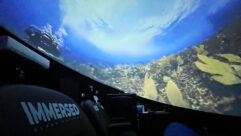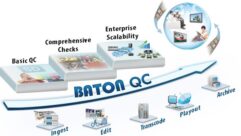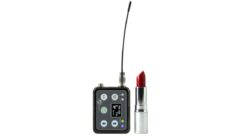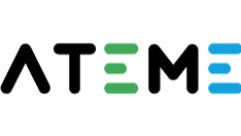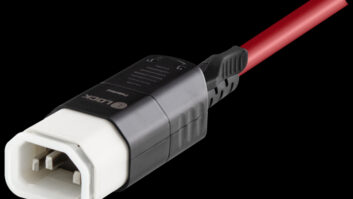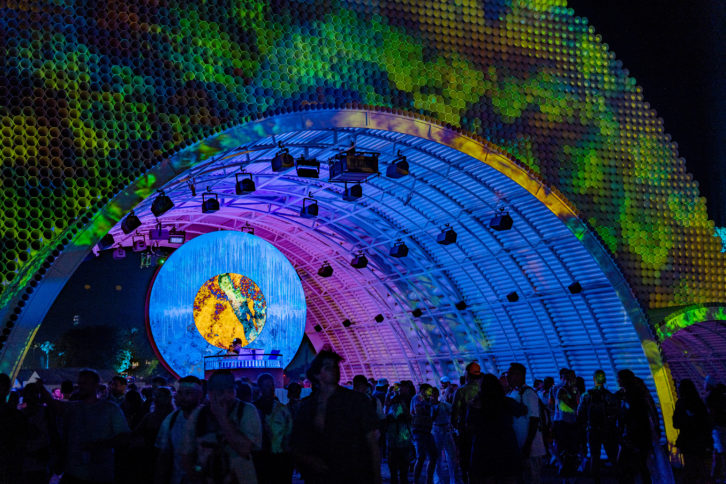
One of the biggest differences about the return to entertainment venues is how far immersive sound has come in the Covid years. While most of the spatial and immersive audio technology very much predates pandemic— by decades even—as we gather again in entertainment spaces, it seems that artists and engineers are taking the sphere and running with it.
This past April, on the Empire Polo Club grounds in Indio, California, artist Cristopher Cichocki devised a remarkable installation: the five-story-tall Circular Dimensions x Microscape, constructed with more than 25,000 feet of PVC tubes, portraying the artist’s ongoing exploration of water and the history of the desert. The bandshell-shaped pavilion contained a living laboratory where scientists and artists generated experimental “video paintings” by manipulating water, salt, barnacles, and algae from the Salton Sea under microscopes and projecting that activity in real-time inside the pavilion’s “nucleus.”
The stunning visuals had an equally amazing aural component as well, provided by L-Acoustics L-ISA immersive audio technology. A total of 60 speakers were deployed in the tunnel environment by sound designers Jonathan Snipes, who teaches sound design in the theater department at UCLA, and Bobby McElver, a professor of wavefield synthesis at UC San Diego. The 57.1 system featured a combination of L-Acoustics X8 and 5XT coaxial loudspeakers supported by four SB18 subwoofers, while several Kiva II mini line arrays additionally delivered a mono version of the multichannel experience around the exterior of the tunnel.
Notably, the entire system was powered by L-Acoustics’ new LA7.16i amplified controller, which was officially introduced at this year’s ISE and InfoComm. Offering a 16×16 architecture in a 2U chassis with Milan-AVB redundancy, each of the unit’s 16 output channels delivers up to 1300 watts at 8 ohms or 1100 watts at 4 ohms.
“With the new sustainability-focused LA7.16i, we were able to deploy only four amplified controllers occupying eight total rack spaces for this exhibit, which was a huge saving in terms of physical space versus using LA4X or LA12X,” shares L-Acoustics Application Project Engineer Carlos Mosquera. “The LA7.16i also requires significantly less power to operate and generates less than half the heat of our other models, helping the tech room under the stage—where the video gear was also housed—feel less like an oven out in the California desert. Plus, the new amplified controller’s Milan-AVB solution is extremely fast and efficient to configure. Even though we had so many channels, the whole setup and calibration took less than half an hour. Thanks to the RAT Sound team, this was an ideal pilot deployment for the LA7.16i.”
“The audio I typically perform has a very three-dimensional spatialization aspect to it,” explains the artist, Cichocki, whose last name is pronounced “cha-ha-skee” and translates as “silence” in Polish. “Bobby and Jonathan are sound-design professionals whom I’ve often worked with, and they suggested that L-ISA technology had the potential to take three-dimensional spatialization to the next level for Circular Dimensions. As it turned out, the bandshell type of environment I had designed for the installation was perfect for that.”
Cichocki, who performed live DJ sets for several hours each evening, developed hours’ worth of audio content for the installation and performance comprised of tracks of natural sounds and other elements as disparate as Gregorian chants and recordings of speeches by environmentalist Greta Thunberg. These experimental sets evolved from ambient in the daytime, switching gears to a high-energy dancefloor at night, all configured in eight channels and played through Ableton Live.
The ever-evolving library of Circular Dimensions audio content wasn’t officially finalized until opening day, and it was only available in stereo format, raising the question: how does one create an engaging, immersive experience on the fly from only two channels?
 To prepare for the event, Snipes and McElver spent a couple of days with Mosquera to create the system design for this project at the L-ISA Studio in Westlake Village, California, which also uses a large number of X8 and 5XT enclosures.
To prepare for the event, Snipes and McElver spent a couple of days with Mosquera to create the system design for this project at the L-ISA Studio in Westlake Village, California, which also uses a large number of X8 and 5XT enclosures.
“Not knowing what tracks Cristopher would ultimately be using for his sets, Bobby and Jonathan took a variety of tracks—some percussive, some ambient, some melodic—and came up with numerous ways for the artist to control the movement of sound throughout the space with L-ISA,” Mosquera recalls. “First, they created a selection of snapshot presets that Cristopher could intentionally trigger from his iPad, which would cause the audio to move in specific ways around the loudspeakers inside the PVC tunnel. The intensity of these effects could also be controlled with a slider bar on his iPad, much like a wet/dry mix. Second, Bobby and Jonathan created multiple ‘reactive’ effects, which would also prompt audio trajectories—like sending everything to the center or panning audio in a wave from one side to the other. These would be automatically actuated when certain frequencies or other thresholds were crossed in the playback material. This second approach created some really interesting, creative movements without the artist having to initiate them personally. The two approaches combined allowed Cristopher to take any material he wanted to play and decorrelate just two channels into dozens of outputs in L-ISA, creating a pretty incredible aural experience.”
Through the larger final system onsite, as Cichocki was mixing on the fly, the audio content passed through processing engineered by Snipes and McElver. “Cristopher is a visual artist who provided the audio content, but wasn’t rearranging it. He’d be pulling from that content live in the moment, like a DJ, so we weren’t able to pre-author any trajectory information,” confirms McElver. “Instead, Jonathan and I built tools Cristopher could use to pull specific types of sounds and rhythms as he needed them. Some of those were reactive, and everything went through a real-time spectral and timbral analysis, so that it could be connected to other sounds and rhythms that way.”
McElver used Cycling 74’s Max 8 for that analysis, then set up macros using the snapshot feature in the L-ISA Controller, which allowed Cichocki to instantly call up specific bits of audio content, even as the rest of the content continued to play in automated mode through the L-ISA Processor II.
“Cristopher could see where the various audio objects were in the L-ISA Controller on the iPad, and he could change the speed and intensity of the other audio sources using an intensity slider we provided,” says McElver. “He could send sounds flying across the space—‘trajectory gestures’—but then the system would revert back to automated mode, so there was never any interruption to the sound.”
Snipes describes himself as the “middleware man” on the project, creating the means for Cichocki to keep adding and changing the audio yet never letting it stop playing. “I was looking for the sweet spot where he could have control over the performance and its intensity and other parameters, but also making sure there was sound activity going on at every moment, some of which was random and some reactive,” he says. “What L-ISA brought to this project was a way to put all of those discrete sound sources in one place and then let them move and keep moving, either intentionally or automatically. L-ISA has the tools for that, and it’s robust enough to do it in a desert environment.”
“What we accomplished with L-ISA was nothing short of spectacular,” Cichocki adds. “It was thrilling watching as people moved through the tunnel and wondered how the sound could move around the way it did. It put the sound on the same level as the visuals. That’s pretty remarkable in the art-installation world.”
At AREA15, the new art and entertainment district located minutes from the Las Vegas Strip, a vast, 200,000 square foot interior houses a collection of themed retail and entertainment options. One principal attraction is a space called “The Portal” where, behind imposing metal doors, visitors can plunge into a 360-degree projection-mapped video experience supported by immersive audio enabled by Meyer Sound’s new Spacemap Go spatial sound design and live mixing tool.
The 6,584 square foot Portal was initially conceived primarily as a large meeting and event space, one that could compete with the posh hotel ballrooms on the Las Vegas Strip with a unique ambience. To that end, the projection systems were designed for four-wall coverage allowing surround video for either the entire space, or for one or two walls when the room was subdivided into smaller spaces.
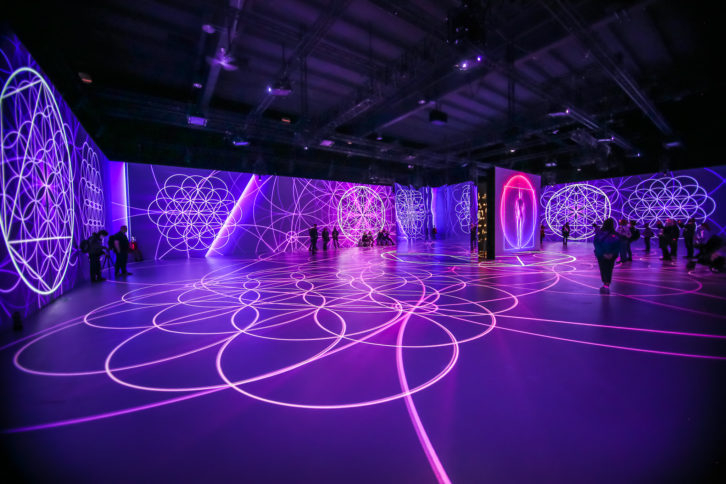 “When Steve Ellison of Meyer Sound first introduced me to Spacemap Go, I didn’t quite get it,” admits David Johngrass, production manager at AREA15. “I figured I could do much the same thing with our digital console. But he pointed out that I would have to do things like bounce out a new track, and then drop it back into the show file. But with Spacemap Go I could do it on the fly, in real time, and here in the space so I know exactly the effect I’m getting. That’s when it clicked. This is huge, I thought.”
“When Steve Ellison of Meyer Sound first introduced me to Spacemap Go, I didn’t quite get it,” admits David Johngrass, production manager at AREA15. “I figured I could do much the same thing with our digital console. But he pointed out that I would have to do things like bounce out a new track, and then drop it back into the show file. But with Spacemap Go I could do it on the fly, in real time, and here in the space so I know exactly the effect I’m getting. That’s when it clicked. This is huge, I thought.”
Some basic spatial sound trajectories were incorporated into the first experience in The Portal, Gallerie 360, a 30-minute sound and light exhibition by digital artists Darpan and Max Cooper. “We’ve just scratched the surface with Spacemap Go,” says Johngrass. “But over the coming months, as we move toward full reopening, we will be using it big time as we start pumping out more theatrical shows where we can fully utilize these tools.”
The overhead Meyer Sound system supporting Spacemap Go — along with the other presentation modes — comprises 12 ULTRAX42 loudspeakers in a 3 x 4 grid pattern. Deep bass is augmented by two 750-LFC low-frequency control elements, while the GALAXY 816 Network Platform, originally specified only for loudspeaker processing, now also accommodates Spacemap Go’s spatial sound mixing.
In addition to the overhead system, the pre-COVID-19 plans also called for a direct reinforcement system suitable for both meetings and nightclub-style celebrations. For this application, Solotech specified a Meyer Sound system anchored by 10 LEOPARD line array loudspeakers bolstered on the bottom end by four 1100-LFC and two 900-LFC™ low-frequency control elements. Rounding out the system are four ULTRA-X40™ loudspeakers for fills, four MJF-210 stage monitors and a second GALAXY 816 for system drive and optimization.
System integrator for Meyer Sound installations was Solotech, under the general direction of Aaron Beck, business development executive and senior engineer. Also contributing were Design Engineer and Programmer Brandon Andreasen and Project Manager Kevin Roberts.
The Genius Immersive Experience is all about the universal genius Leonardo DaVinci. Offering visitors an interpretation of how DaVinci would see and interact with our world today, the exhibition is designed as an immersive, interactive art experience. The immersive sound element is provided by a d&b Soundscape system.
The experience transports visitors into DaVinci’s world of thought; both the images and the soundtrack move with the exhibit.
The experience was realized by, among others, the organizer BIG Borealis and the design studio flora&faunavisions. d&b partner Amptec was responsible for providing the audio equipment and installing the d&b Soundscape system.
The d&b Soundscape is a scalable, high-resolution platform. It enables the user to create immersive experiences. Its En-Scene software enables object-based mixing while its En-Space software is a premium, plug and play acoustic emulation software based on acoustic signatures of some of the world’s leading performance venues.
For this setup, Amptec installed 32 10S-D loudspeakers, mounted in a ring above the huge screens throughout the room. In addition, six 18A and one 21S subwoofers were placed at the centre. At the cube in the centre of the large hall, in addition Amptec installed three 8S loudspeakers on the outside and two 8S inside the cube.
“To achieve a perfect result, we had to keep an exact distance between the speakers and a precisely calculated angulation,” says Frank Geerts, Business Unit Manager PA & Theatre at Amptec. “This precision allowed us to create a perfect immersive experience.”
The technical team at Amptec managed by Steven Aerts programmed the DS100 signal engine and created various presets. The Soundscape system is designed in such a way that it can easily be reproduced in other locations, a crucial requirement as the show will be visiting other countries around the world. “To my knowledge, this approach is pretty unique, as immersive show concepts are usually only ever designed for a single venue. By coming up with this model [using Soundscape], the end user is able to simply deploy the original concept to any venue,” Geerts adds.
The DS100 Signal Engine from d&b audiotechnik sits at the heart of the Soundscape system. The network- and Dante-enabled DSP platform can manage 64 inputs and outputs in parallel and takes care of the distribution of the individual audio tracks. In addition to the DS100 three DS10 Audio Network Bridges are used for the Genius system design, which serve as an interface between the Dante network and digital AES3 audio signals.
The seamless interaction of d&b loudspeakers, processors, matrices, the audio files and the right installation made this interactive and immersive experience possible.
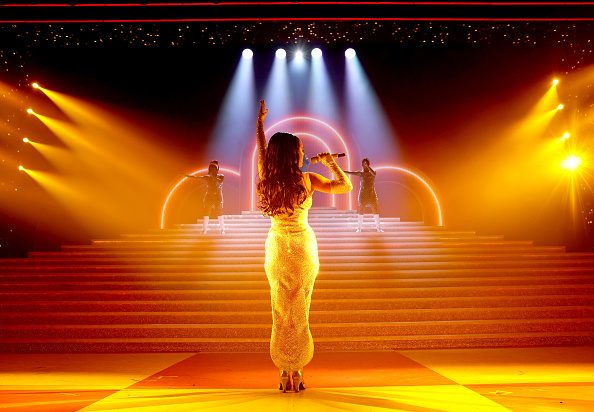
Genius DaVinci will be in Berlin until 31st July 2022 and the innovative multimedia exhibition will be on show in 12 other locations in Europe and the USA until 2025.
The new 5,000-capacity Resorts World Theatre, operated by Concerts West / AEG Presents is home to the first fixed install of L-Acoustics L-ISA Immersive Hyperreal Sound technology in Las Vegas. More than 200 loudspeakers comprise an immersive aural environment that stands out even by Las Vegas standards.
Montreal-based Scéno Plus served as the theatre designer, further overseeing the venue’s technology, while L-Acoustics Certified Provider (CPi) Solotech integrated the 14.1 audio system with design support from the L-Acoustics Application team. The system consists of an L-ISA Scene setup of seven arrays of 14 K2 enclosures flown across the stage width, left-right out-fill arrays of 12 Kara, plus two center-flown arrays of eight KS28 subs each. Twenty-four KS21 subs are located under the stage, and 16 5XT five-inch coaxials are positioned across the stage lip, functioning as spatial front-fills thanks to a new L-ISA algorithm. Many A10i Wide enclosures provide delay and seven channels of surround for each of the three balconies, with additional A10i found in the lighting booth. A combination of LA12X, LA4X, and LA2Xi amplified controllers drive the system, which also uses the new L-ISA Processor II—the device’s first permanent install. Plus, there are 11 P1 processors installed that enable bridging of AVB, AES/EBU, and analog audio with time-aligned redundant signal distribution.
What Aaron Beck, Business Development Manager & Senior Engineer at Solotech, found most notable about the L-ISA implementation was how routine their installation seemed. It was Solotech’s first permanent installation of the system, and Beck found the process remarkably straightforward, suggesting that L-ISA was becoming as mainstream as conventional sound systems when it comes to installation.
“Our live production division had some experience using L-ISA, but this was our first time using the technology on a permanent installation,” he says. “What was different this time was that the new installation versions of the A Series speakers were available, replacing the X8 and X12 enclosures for rear surrounds and delays in our previous design. As a result, we were able to reduce the overall count of speakers with the slightly larger A Series, which saved the client some costs. The new L-ISA Processor II is also more powerful and includes the ability to bring an immersive experience even down to the front-fill speakers.”
Beck added that the installation was aided by L-ISA’s interoperability with AVB networking. “Having the amplifiers for the main front system on the stage grid directly above the line arrays was extremely beneficial as we didn’t have to have 60 amplifiers in amp room two floors away, reducing a huge amount of cable, conduit, and installation time,” he says.
“When you’re sitting in the Theatre, you can have a normal conversation with the person next to you even as the music is happening,” says rançois Blais, Vice President of Technology and Specialized Equipment at Scéno Plu. “The L-ISA system is about being wide rather than loud. It’s been wonderful to watch visiting engineers encounter it for the first time and how they discover new ways of making the music come across.”


